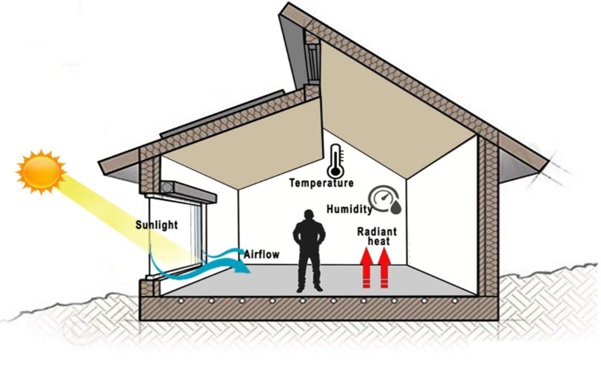ANALYTICAL STUDY TO REDUCE HEAT IN BUILDING FRAME SYSTEM
Main Article Content
Abstract
This research was to improve the efficiency of building frames because Thailand is located in a tropical climate zone. Causing the current building to have a hot climate, which wastes electricity costs, we therefore need to pay attention to the building frame. A good building frame should be able to prevent too much heat from entering the building. to reduce the cooling load of the air conditioning system And leads to a reduction in the use and cost of wasting electricity. Normally, the air conditioning load caused by heat transfer from the outside of the building into the building. Will have a higher proportion than the heat generated within the building itself the way we can understand the mechanism of heat transfer into the building is how it is. What are the characteristics and know how to assess the performance of the building frame It allows us to analyze to find ways to prevent those heat from entering the building for a particular building. Air conditioning load is affected by external factors. including the heat that is transferred from the outside of the building into the building and from internal factors such as heat generated from within the building itself, usually The heat from the outside will have a higher proportion than the heat from the inside, i.e. 60% of the air conditioning load
Article Details

This work is licensed under a Creative Commons Attribution-NonCommercial-NoDerivatives 4.0 International License.
เนื้อหาและข่อมูลในบทความที่ลงตีพิมพ์ในวารสารวิชาการ เทคโนโลยี พลังงาน และสิ่งแวดล้อม บัณฑิตวิทยาลัย วิทยาลัยเทคโนโลยีสยาม ถือเป็นข้อคิดเห็นและความรับผิดชอบของผู้เขียนบทความโดยตรง ซึ่งกองบรรณาธิการวารสารไม่จำเป็นต้องเห็นด้วย หรือว่าร่วมรับผิดชอบใด ๆ
บทความ ข้อมูล เนื้อหา รูปภาพ ฯลฯ ที่ได้รับการตีพิมพ์ในวารสารวิชาการ เทคโนโลยี พลังงาน และสิ่งแวดล้อม บัณฑิตวิทยาลัย วิทยาลัยเทคโนโลยีสยาม ถือเป็นลิขสิทธิ์ของวารสารวิชาการ เทคโนโลยี พลังงาน และสิ่งแวดล้อม บัณฑิตวิทยาลัย วิทยาลัยเทคโนโลยีสยาม หากบุคคล หรือหน่วยงานใดต้องการนำทั้งหมด หรือส่วนหนึ่งส่วนใดไปเผยแพร่ต่อ หรือเพื่อกระทำการใด ๆ จะต้องได้รับอนุญาต เป็นลายลักษณ์อักษรจากวารสารวิชาการ เทคโนโลยี พลังงาน และสิ่งแวดล้อม บัณฑิตวิทยาลัย วิทยาลัยเทคโนโลยีสยาม เท่านั้น
References
กรมพัฒนาพลังงานทดแทนและอนุรักษ์พลังงาน, (2547), ตำราฝึกอบรมหลักสูตรผู้รับผิดชอบด้านพลังงาน
(ผชพ.)สามัญ
กรมพัฒนาพลังงานทดแทนและอนุรักษ์พลังงาน, (2550), คู่มือมาตรฐานการอนุรักษ์พลังงานในอาคารกรม
พัฒนาพลังงานทดแทนและอนุรักษ์พลังงาน กระทรวงพลังงาน. (พ.ศ. 2545). บทที่ 2 การเลือกใช้
วัสดุอุปกรณ์ก่อสร้างที่มีคุณสมบัติความเป็นฉนวน 10 ชนิด. In เอกสารเผยแพร่ แนวทางการ
เลือกใช้วัสดุก่อสร้างและฉนวนเพื่อการอนุรักษ์พลังงาน (pp. 2-1 - 2-15)
ผศ.ดร.สุธรรม นิยมวาส และบัญญัติ นิยมวาส, (2549). เครื่องจักรกลของไหล, สํานักพิมพ์วิทยพัฒน์ จํากัด,
กรุงเทพฯ, [4] เกษม จันทร์แก้ว และคณะ. (2543). โครงการศึกษาวิจัย และพัฒนาสิ่งแวดล้อมแหลมผักเบี้ย อัน
เนื่องมาจาก พระราชดำริ.ตำบลแหลมผักเบี้ยอำเภอบ้านแหลม: เพชรบุรี
ชัยโรจน์ธนสันติ. (2535).การมีส่วนร่วมของสภาตำบลในการอนุรักษ์ทรัพยากรธรรมชาติ:ศึกษากรณีจังหวัด
อุบลราชธานี.วิทยานิพนธ์สังคมศาสตร์มหาบัณฑิต สาขาสิ่งแวดล้อม, บัณฑิตวิทยาลัย มหาวิทยาลัยมหิดล
คู่มือฝึกกอบรมการอนุรักษ์พลังงานภาคปฏิบัติด้านไฟฟ้า (Mini Plant), โครงการทดลองจัดระบบการสอบและ
การพัฒนาหลักสูตรฝึกกอบรม PRE, กรมพัฒนาพลังงานทดแทนและอนุรักษ์พลังงาน
ศราพร ไกรยะปักษ์. (2553).รูปแบบที่เหมาะสมในการจัดการพลังงานชุมชน.วิทยานิพนธ์ วิทยาศาสตร์
มหาบัณฑิต สาขาสิ่งแวดล้อม, บัณฑิตวิทยาลัย มหาวิทยาลัยมหิดล
นิพนธ์เกตุจ้อย. ( 2546).ระบบไฟฟ้าขนาดเล็กจากพลังงานหมุนเวียนสำหรับหมู่บ้านที่ไม่มีไฟฟ้าใช้ในประเทศ
ไทย.ศูนย์วิจัยและฝึกอบรมพลังงานแสงอาทิตย์, มหาวิทยาลัยนเรศวร พิษณุโลก
Cohen, J.M. และ N.T. Up off. (1977), Rural Development Participation: Concept and Measures for
Project Design Implementation and Evaluation. Rural Development Committee Center for International
Studies, Cornell University.
Boyle. (1996). Renewable Energy Power for a Sustainable Future. New York: Oxford University Press
Lars Kroldrup,(2010), Gains in Global Wind Capacity Reported Green
Inc,http://green.blogs.nytimes .com/author/lars-kroldrup/Ristinen , Robert A.&Kraushaar,Jack. J ,(1999)
Energy and the Environment, New York: John Wiley & Son –
http://greenthefuture.com/HYDROELECTRIC_DIY_WATERWHEEL.html ,Vertical wind turbine


